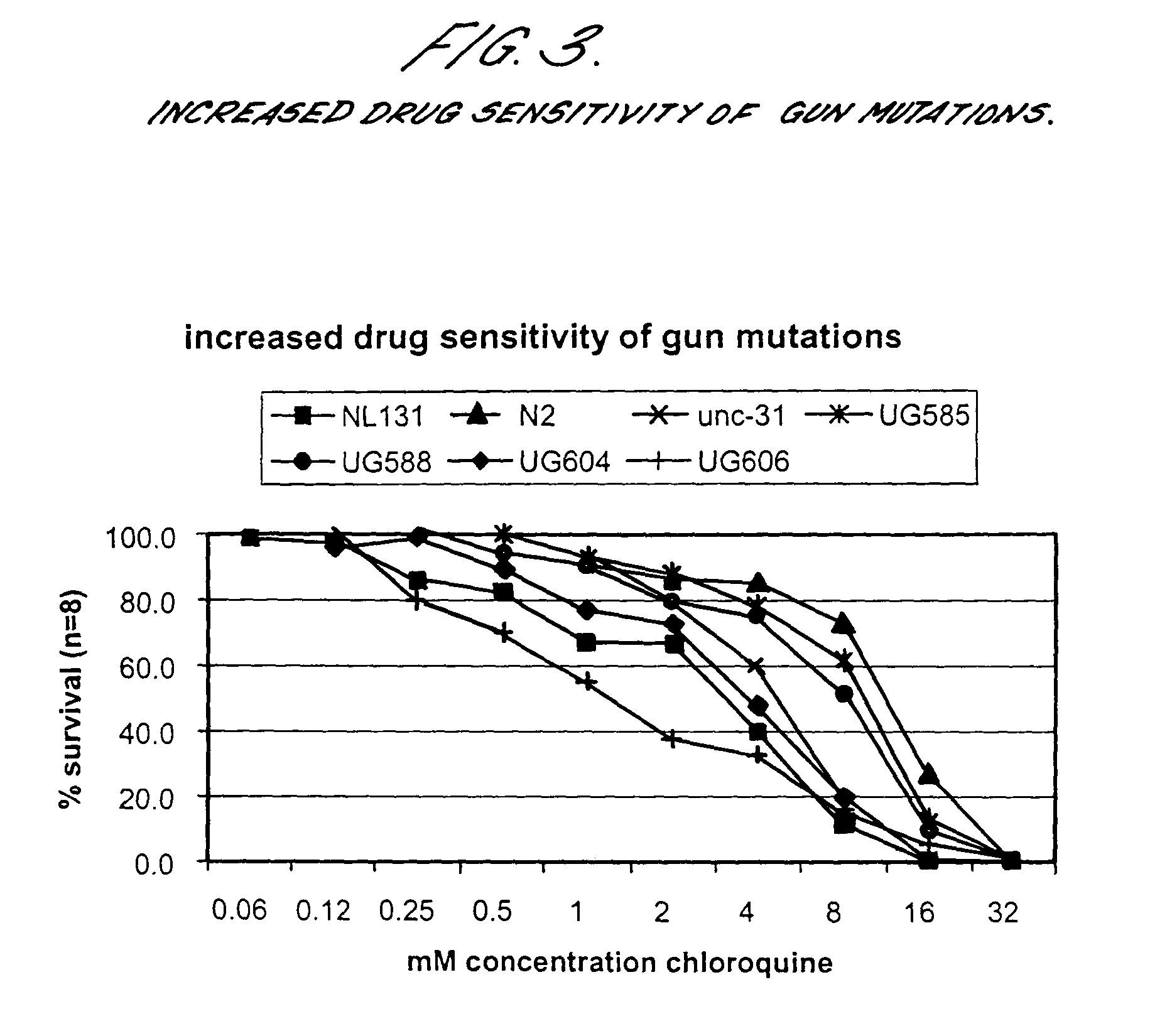Caenorhabditis elegans strain HD8: a mutant exhibiting constitutive pharyngeal pumping
- Summary
- Abstract
- Description
- Claims
- Application Information
AI Technical Summary
Benefits of technology
Problems solved by technology
Method used
Image
Examples
example 1
[0062]About 2000 late fourth-larval-stage (L4) C. elegans (N2 strain) hermaphrodites were mutagenised by exposure to 50 mM EMS for 4 hours at 20° C. under agitation. Mutagenised worms were then inoculated onto 10 cm nutrient agar plates. Eggs were collected from the F1 progeny and allowed to hatch on the nutrient agar plates. Young F2 adult hermaphrodites were then screened for their ability to stain with calcein-AM. The individuals that were gut stained within 15 minutes were then selected. These worms were mutants with constitutive pharynx pumping and an example is shown in FIG. 1. Those individuals for which the body was also fully stained were shown to have a defective or permeabilized cuticle. The results are shown in Table 1 below.
[0063]
TABLE 1ConstitutiveUn-Full stainingC. eleganspharynxcoordinatedOtherofnematodepumpingmovementobservationsbody cavityN2−−−−(wild-type)Unc-31+++++−−(e928)(collectionstrain)Lon-1+!−−!(collectionstrain)9B2 (bg44)+−Eggs, fertility+−3D5++−− / +HD8 (bg4...
example 2
[0064]The genetics of the C. elegans gut barrier and detoxification mechanisms.
1. P-glycoproteins
[0065]Pgps mediates drug resistance by acting as an ATP-dependent efflux pump removing various lipophilic cytotoxic compounds with the following features (apart from heavy metal specific Pgps):[0066]at least one, preferentially several, planar aromatic ring structures,[0067]a cationic charge at physiological pH and[0068]a molecular weight around 400 or higher
[0069]While in humans two Pgp encoding genes are known, of which MDR1 is involved in multi drug resistance, the sequence of C. elegans reveals 15 Pgp genes, many of them located in clusters on the X chromosome.
[0070]
TABLE 2GenelocationexpressionmutationfunctionPgp-3X 3.3apical membranepk18Multi drug resistance: deletionZK 455.7of intestinal cellsmutation increases sensitivity toF42E11and excretory cellcolchicine 8 fold, chloroquine 3fold, emetine not increased,ivermectine not increasedPgp-4X 3.3excretory cellF42E11Pgp-1IV 6.0intestin...
example 3
[0094]Selecting C. elegans mutations for increased gut uptake (gun) using marker dye BCECF-AM and unc-31 as background.
[0095]The screen was performed in unc-31(e928) mutant background, to ensure high amounts of dye in the gut lumen, since unc-31 mutations show constitutive pharyngeal pumping. The dye (BCECF-AM: 2′,7′ bis (2-carboxyethyl)-5-(and-6)-carboxyfluorescein, acetoxymethylester), obtained from Molecular Probes, is cleaved by intracellular esterases. Fluorescence accumulates in the gut cells upon passage through the apical gut membrane.
[0096]Day 1: unc-31 L4 staged worms were mutagenised with EMS (final concentration 50 mM) for 4 hours[0097]Day 2: P0 was divided over several large agar plates[0098]Day 6: F1's were collected and dropped on large plates. The number of eggs the F1?s layed were checked every hour and de F1?s were removed when 10–20 eggs per F1 were counted[0099]Day 10: F2 adults were collected and screened with BCECF-AM. Mutations with increased staini...
PUM
| Property | Measurement | Unit |
|---|---|---|
| Fraction | aaaaa | aaaaa |
| Fraction | aaaaa | aaaaa |
| Length | aaaaa | aaaaa |
Abstract
Description
Claims
Application Information
 Login to View More
Login to View More - R&D
- Intellectual Property
- Life Sciences
- Materials
- Tech Scout
- Unparalleled Data Quality
- Higher Quality Content
- 60% Fewer Hallucinations
Browse by: Latest US Patents, China's latest patents, Technical Efficacy Thesaurus, Application Domain, Technology Topic, Popular Technical Reports.
© 2025 PatSnap. All rights reserved.Legal|Privacy policy|Modern Slavery Act Transparency Statement|Sitemap|About US| Contact US: help@patsnap.com



